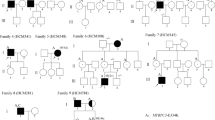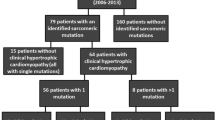Abstract
Background. With the improvement in genetic testing over time, double-heterozygous mutations are more often found by coincidence in families with hypertrophic cardiomyopathy (HCM). Double heterozygosity can be a cause of the wellknown clinical diversity within HCM families.
Methods and results. We describe a family in which members carry either a single mutation or are double heterozygous for mutations in myosin heavy chain gene (MYH7) and cysteine and glycine-rich protein 3 (CSRP3). The described family emphasises the idea of a more severe clinical phenotype with double-heterozygous mutations. It also highlights the importance of cardiological screening where NT-proBNP may serve as an added diagnostic tool.
Conclusion. With a more severe inexplicable phenotype of HCM within a family, one should consider the possibility of double-heterozygous mutations. This implies that in such families, even when one disease-causing mutation is found, all the family members still have an implication for cardiological screening parallel to extended genetic screening. (Neth Heart J 2009;17:458–63.)
Similar content being viewed by others
References
Maron BJ, Gardin JM, Flack JM, et al. Prevalence of hypertrophic cardiomyopathy in a general population of young adults. Echocardiographic analysis of 4111 subjects in the CARDIA Study. Coronary Artery Risk Development in (Young) Adults. Circulation. 1995;92:785–9.
Maron BJ, Nichols PF, 3rd, Pickle LW, et al. Patterns of inheritance in hypertrophic cardiomyopathy: assessment by M-mode and twodimensional echocardiography. Am J Cardiol 1984;53:1087–94.
Richard P, Charron P, Carrier L, et al. Hypertrophic cardiomyopathy: distribution of disease genes, spectrum of mutations, and implications for a molecular diagnosis strategy. Circulation. 2003;107:2227–32.
Van Driest SL, Ommen SR, Tajik AJ, et al. Sarcomeric genotyping in hypertrophic cardiomyopathy. Mayo Clinic Proc. 2005;80:463–9.
Van Driest SL, Jaeger MA, Ommen SR, et al. Comprehensive analysis of the beta-myosin heavy chain gene in 389 unrelated patients with hypertrophic cardiomyopathy. J Am Coll Cardiol. 2004;44:602–10.
Towbin JA. Molecular genetics of hypertrophic cardiomyopathy. Curr Cardiol Reports. 2000;2:134–40.
Geier C, Perrot A, Ozcelik C, et al. Mutations in the human muscle LIM protein gene in families with hypertrophic cardiomyopathy. Circulation. 2003;107:1390–5.
Ho CY, Seidman CE. A contemporary approach to hypertrophic cardiomyopathy. Circulation. 2006;113:e858–62.
Alders M, Jongbloed R, Deelen W, et al. The 2373insG mutation in the MYBPC3 gene is a founder mutation, which accounts for nearly one-fourth of the HCM cases in the Netherlands. Eur Heart J. 2003;24:1848–53.
Maron BJ, Chaitman BR, Ackerman MJ, et al. Recommendations for physical activity and recreational sports participation for young patients with genetic cardiovascular diseases. Circulation. 2004;109:2807–16.
Nguyen L, Chung J, Lam L, et al. Abnormal cardiac response to exercise in a murine model of familial hypertrophic cardiomyopathy. Int J Cardiol. 2007;119:245–8.
Tsoutsman T, Bagnall RD, Semsarian C. Impact of multiple gene mutations in determining the severity of cardiomyopathy and heart failure. Clin Exp Pharmacol Physiol. 2008;35:1349–57.
Ingles J, Doolan A, Chiu C, et al. Compound and double mutations in patients with hypertrophic cardiomyopathy: implications for genetic testing and counselling. J Med Genet. 2005;42:e59.
van Langen IM, Arens Y, Baars H, et al. Concept Multidisciplinaire richtlijn. Genetische diagnostiek en erfelijkheidsadvisering bij Hypertrofische Cardiomyopathie (HCM). Submitted 2009.
Michels M, Hoedemaekers YM, Kofflard MJ, et al. Familial screening and genetic counselling in hypertrophic cardiomyopathy: the Rotterdam experience. Neth Heart J. 2007;15:184–90.
Marian AJ. Modifier genes for hypertrophic cardiomyopathy. Curr Opin Cardiol. 2002;17:242–52.
Van Driest SL, Vasile VC, Ommen SR, et al. Myosin binding protein C mutations and compound heterozygosity in hypertrophic cardiomyopathy. J Am Coll Cardiol. 2004;44:1903–10.
Alpert NR, Mohiddin SA, Tripodi D, et al. Molecular and phenotypic effects of heterozygous, homozygous, and compound heterozygote myosin heavy-chain mutations. Am J Physiol. 2005;288:H1097–102.
Bos JM, Poley RN, Ny M, et al. Genotype-phenotype relationships involving hypertrophic cardiomyopathy-associated mutations in titin, muscle LIM protein, and telethonin. Mol Gen Metabol 2006;88:78–85.
Schiller NB, Shah PM, Crawford M, et al. Recommendations for quantitation of the left ventricle by two-dimensional echocardiography. American Society of Echocardiography Committee on Standards, Subcommittee on Quantitation of Two-Dimensional Echocardiograms. J Am Soc Echocardiogr. 1989;2:358–67.
Gruver EJ, Fatkin D, Dodds GA, et al. Familial hypertrophic cardiomyopathy and atrial fibrillation caused by Arg663His betacardiac myosin heavy chain mutation. Am J Cardiol. 1999;83:13H–8H.
Greber-Platzer S, Marx M, Fleischmann C, et al. Beta-myosin heavy chain gene mutations and hypertrophic cardiomyopathy in Austrian children. J Mol Cell Cardiol. 2001;33:141–8.
Song L, Zou Y, Wang J, et al. Mutations profile in Chinese patients with hypertrophic cardiomyopathy. Clin Chim Acta; Int J Clin Chem. 2005;351:209–16.
Sadoul N, Simon JP, de Chillou C, et al. Dual chamber pacemaker therapy in obstructive hypertrophic cardiomyopathy. Circulation. 1995;92:1062–4.
Bos JM, Theis JL, Tajik AJ, et al. Relationship between sex, shape, and substrate in hypertrophic cardiomyopathy. Am Heart J. 2008;155:1128–34.
Knoll R, Hoshijima M, Hoffman HM, et al. The cardiac mechanical stretch sensor machinery involves a Z disc complex that is defective in a subset of human dilated cardiomyopathy. Cell. 2002;111:943–55.
Mohapatra B, Jimenez S, Lin JH, et al. Mutations in the muscle LIM protein and alpha-actinin-2 genes in dilated cardiomyopathy and endocardial fibroelastosis. Mol Gen Metabol. 2003;80:207–15.
Tsoutsman T, Kelly M, Ng DC, et al. Severe heart failure and early mortality in a double-mutation mouse model of familial hypertrophic cardiomyopathy. Circulation. 2008;117:1820–31.
Magga J, Sipola P, Vuolteenaho O, et al. Significance of plasma levels of N-terminal Pro-B-type natriuretic peptide on left ventricular remodeling in non-obstructive hypertrophic cardiomyopathy attributable to the Asp175Asn mutation in the alpha-tropomyosin gene. Am J Cardiol. 2008;101:1185–90.
Hansen MW, Merchant N. MRI of hypertrophic cardiomyopathy: part I, MRI appearances. AJR Am J Roentgenol. 2007;189:1335–43.
Germans T, van Rossum AC. The use of cardiac magnetic resonance imaging to determine the aetiology of left ventricular disease and cardiomyopathy. Heart. 2008;94:510–8.
Moon JC, Mogensen J, Elliott PM, et al. Myocardial late gadolinium enhancement cardiovascular magnetic resonance in hypertrophic cardiomyopathy caused by mutations in troponin I. Heart. 2005;91:1036–40.
Germans T, Wilde AA, Dijkmans PA, et al. Structural abnormalities of the inferoseptal left ventricular wall detected by cardiac magnetic resonance imaging in carriers of hypertrophic cardiomyopathy mutations. J Am Coll Cardiol. 2006;48:2518–23.
Author information
Authors and Affiliations
Corresponding author
Additional information
Department of Cardiology, Maastricht University Medical Center, Maastricht, the Netherlands
Departments of Cardiology and Clinical Genetics, Maastricht University Medical Center, Maastricht, the Netherlands
Department of Clinical Genetics, Maastricht University Medical Center, Maastricht, the Netherlands
Department of Molecular Genetics, Maastricht University Medical Center, Maastricht, the Netherlands
Department of Cardiology, Academic Medical Center, Amsterdam, the Netherlands
I.A.W van Rijsingen Department of Cardiology, Academic Medical Center, University of Amsterdam, PO Box 22660, 1100 DD Amsterdam, the Netherlands
Rights and permissions
About this article
Cite this article
van Rijsingen, I.A.W., Ast, J.F.Hv., Arens, Y.H.J.M. et al. Hypertrophic cardiomyopathy family with double-heterozygous mutations; does disease severity suggest doubleheterozygosity?. NHJL 17, 458–463 (2009). https://doi.org/10.1007/BF03086304
Issue Date:
DOI: https://doi.org/10.1007/BF03086304




